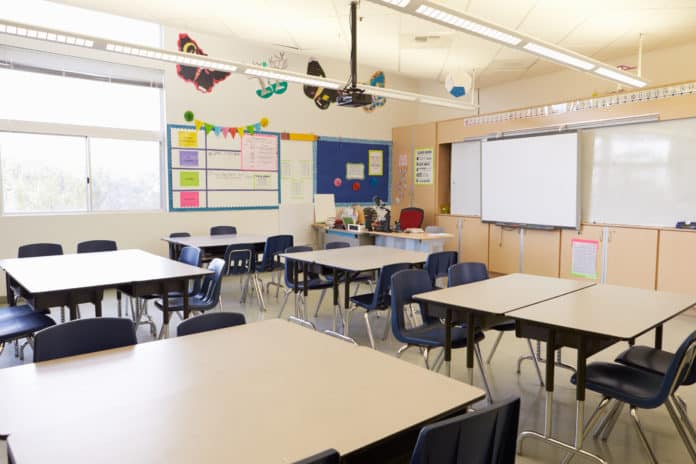Minnesota teachers are leaving the classroom in droves. Noting the state is down about 1,000 teachers, Education Minnesota President Denise Specht recently said the way to improve retention is to offer better pay and benefits and ensure teachers feel respected and supported.
Be it the teachers union or the Walz administration, the solution is always more money. Hence, the constant push to “fully fund” schools. But is compensation driving teachers out of the work force? Perhaps, though it’s more likely the lack of respect and support and the poor working conditions.
People leave jobs when they don’t feel safe, appreciated, or able to do them effectively. Take law enforcement. Since George Floyd’s death, cops have been physically attacked and demonized as racists. Demoralized, they’ve walked away from careers they once enjoyed.
The phenomenon is repeating itself with teachers. Like a dysfunctional relationship, there’s little transparency. Teachers feel pressured not to air dirty laundry. They fear repercussions if they speak up.
But as the numbers demonstrate, many are fed up. So, they’re speaking up, though anonymously, which is how I’m able to share their stories.
Whether they’re in elementary, middle, or high school, teach history, math, science, or foreign language, they paint a deeply disturbing picture of today’s metro-area public schools.
They’ve all spent decades teaching. Many have children who went through the system.
They love their students and they’ve loved their jobs. But the joy is gone. They fear for their safety and their students’ safety. They don’t feel supported by the administration. They’re frustrated by bureaucrats who create policies without entering the buildings or seeing the ramifications.
Most students want to learn and follow the rules. But a small number of students are creating a hellish experience for all.
One teacher said, “It’s not a leaky pipe. The pipe has been obliterated into smithereens. There’s no patch that’s going to fix this.”
Another said, “What I’m seeing and what makes me want to quit my job is I can’t teach. I’m good at what I do. But I can’t deliver content because all I do is stand in front of the room and ask kids to please stop talking.”
One of the saddest stories came from a middle-school teacher whose first year in a new building got off to a horrific start. She had asked a student to stop dribbling a basketball in the hallway while class was in session. His response: “F you. Get out of my face.” When he came after her, she barricaded herself behind a locked door, as he shook it and called her a bitch.
When she reached out to the principal, she got no support, just a reminder to complete a reflection form stating what happened and what interventions she employed. She’ll never learn the resolution of any reflection forms, she said.
Her mental health is suffering. She must talk herself into going to work. “I drive to school in the morning, and I can’t get out of my car,” she said.
The teachers’ working environment is the students’ learning environment. Most students show up to learn. They watch as a minority of students disrupt the classroom and the lunchroom with behaviors ranging from disobedience to outright crime. The accounts are grim.
A student kicked a pregnant teacher in the stomach.
With Bunsen burners ignited, students engaged in a fist fight in a science classroom.
Students vape and fight in restrooms. They throw paper balls in the classroom. They buy and sell drugs.
A first grader ran on the windowsills as classmates sat and watched.
Students refuse to clean up after themselves in the cafeteria, leaving dirty trays on tables, applesauce and Ketchup packets on the floors. One teacher said, “I have a master’s degree and 20 years of experience, but I’m a glorified custodian.”
Phones are the teachers’ nemesis. Some schools have banned or limited them in classrooms. Others have not. When there’s no dress code, students can pull hoods over their heads, plug in ear buds, and tune out. Others brazenly use them.
Last week, Liz Collin shared the story of a St. Paul teacher who was sworn at and threatened by a student who said, “Shut the fuck up you bitch ass ho.” Bruce Ringaman gave the principal an ultimatum: either the student leaves or he would.
The student stayed. Ringaman left.
We’re living in an era of low expectations with dire consequences. We’ve seen the videos and read news accounts. Toddlers in diapers swearing at uniformed police officers; girls fighting in school bathrooms; and juveniles holding civilians at gunpoint, sometimes as children look on, demanding car keys, cellphones, and wallets.
Today’s toddlers are tomorrow’s school students. Today’s school students are tomorrow’s carjackers. But they’re also tomorrow’s doctors, software engineers, and artists. And their educations are being hijacked by a few.
The Star Tribune recently ran a three-part series on juvenile justice. Describing an inadequate system in disarray, it focused on a dearth of programs to support juveniles — without addressing individual responsibility. And yet, that’s a huge part of the problem.
Teachers are frustrated by their inability to impose reasonable discipline, as they did in the past. Instead, they are required to use restorative practices. It’s an equity-driven disciplinary approach with no teeth. When students engage in disruptive or dangerous behavior, teachers must complete forms and call parents — while other students sit at their desks, often on their phones.
The approach is time-consuming, disruptive, and ineffective. Since incidents do not seem to be consistently reported, it skews data.
If parents don’t hold children accountable at home; if teachers can’t hold them accountable at school; if prosecutors don’t impose meaningful bail or penalties, why should young people follow any rules?
This “high stakes environment” impacts students’ academic achievement. It also bleeds into life outside of school. One teacher said, “This behavior piece for 5 to 10 percent of students is truly a life and death situation,” adding, “We teach kids that when somebody says stop you don’t have to stop if you don’t want to.”
Though some schools face more challenges than others, eventually, like the merge lane on the freeway, students from all school districts will blend into the next generation of adults. Today’s lessons will shape tomorrow’s choices and behavior.
The behavioral problems are one chapter in a complex story. And not every chapter is discouraging. As one teacher said, great things are still happening in some classrooms. But the teachers do have an assignment. They’d like parents to do their own homework; to ask questions; to pressure principals to make changes; and to support school board candidates who aren’t endorsed by the teachers union.
And, as one teacher said, if the Department of Education wants to know why kids are failing, it should examine the correlation between academics and behavior. Later this week I’ll address the culture of low academic expectations, which goes hand-in-glove with the culture of low behavioral expectations.
The views and opinions expressed in this commentary are those of the author and do not represent an official position of Alpha News.

















